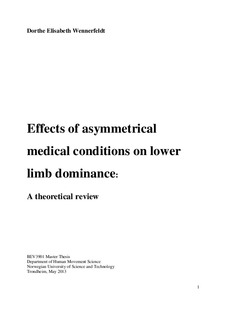| dc.contributor.advisor | Vereijken, Beatrix | nb_NO |
| dc.contributor.author | Wennerfeldt, Dorthe Elisabeth | nb_NO |
| dc.date.accessioned | 2014-12-19T14:44:37Z | |
| dc.date.available | 2014-12-19T14:44:37Z | |
| dc.date.created | 2013-08-20 | nb_NO |
| dc.date.issued | 2013 | nb_NO |
| dc.identifier | 642033 | nb_NO |
| dc.identifier.uri | http://hdl.handle.net/11250/271572 | |
| dc.description.abstract | Research question of the theoretical review: Medical conditions that cause an asymmetry in the functions of the lower extremities – will they also affect limb dominance?
Methods: A theoretical review with searches in databases for articles about the theory behind limb dominance and for articles with various medical conditions that cause asymmetry in the functions of the lower extremities.
Results: In the medical conditions, there were found asymmetries caused by one affected leg or side. There existed a dominant side of the medical conditions responsible for the affected leg. Often the patients showed plasticity. Plasticity made the patients adapt to the medical condition, by creating a functional pattern in movements based on available possibilities. They often created a functional limb dominance. The new patterns were often less consistent and rigid than normal limb dominance. This might suggest that a basis limb dominance still might exist on the brain level.
Conclusion: Medical conditions that cause an asymmetry in the functions of the lower extremities create a dominant limb in terms of dysfunction. This probably leads to a more unilateral action pattern and a change in functional limb dominance. It is suggested that basis limb dominance might still exist on the brain level. If this is correct, it means that if a person receives a brain injury, this might damage or destroy limb dominance on brain level. To be able to say more about limb dominance on the brain level could be a case for future research.
Key words: Medical conditions, functions of the lower extremities, symmetry, dominance. | nb_NO |
| dc.language | eng | nb_NO |
| dc.publisher | Norges teknisk-naturvitenskapelige universitet, Fakultet for samfunnsvitenskap og teknologiledelse, Institutt for bevegelsesvitenskap | nb_NO |
| dc.title | Effects of asymmetrical medical conditions on lower limb dominance: A theoretical review | nb_NO |
| dc.type | Master thesis | nb_NO |
| dc.contributor.department | Norges teknisk-naturvitenskapelige universitet, Fakultet for samfunnsvitenskap og teknologiledelse, Institutt for bevegelsesvitenskap | nb_NO |
